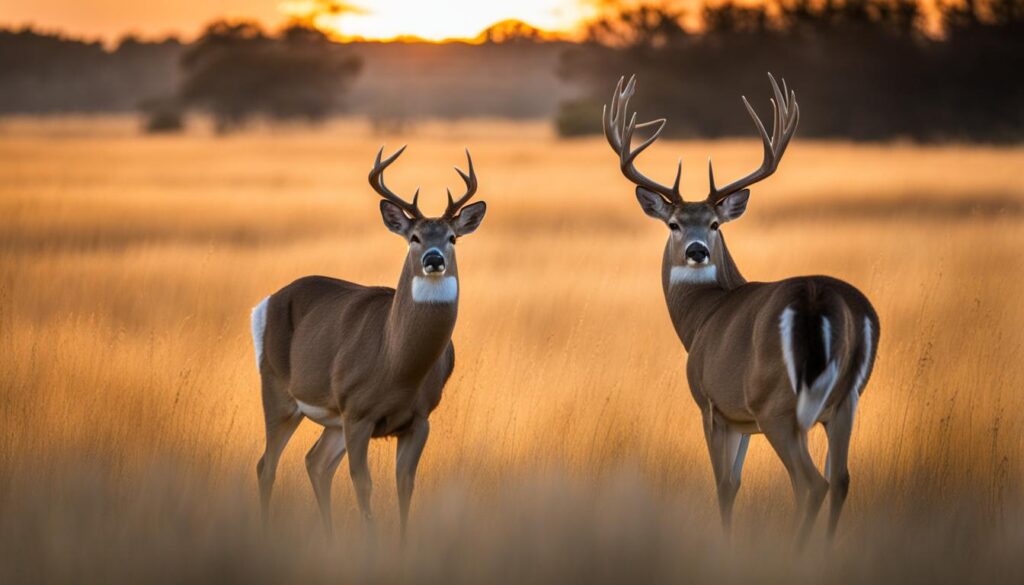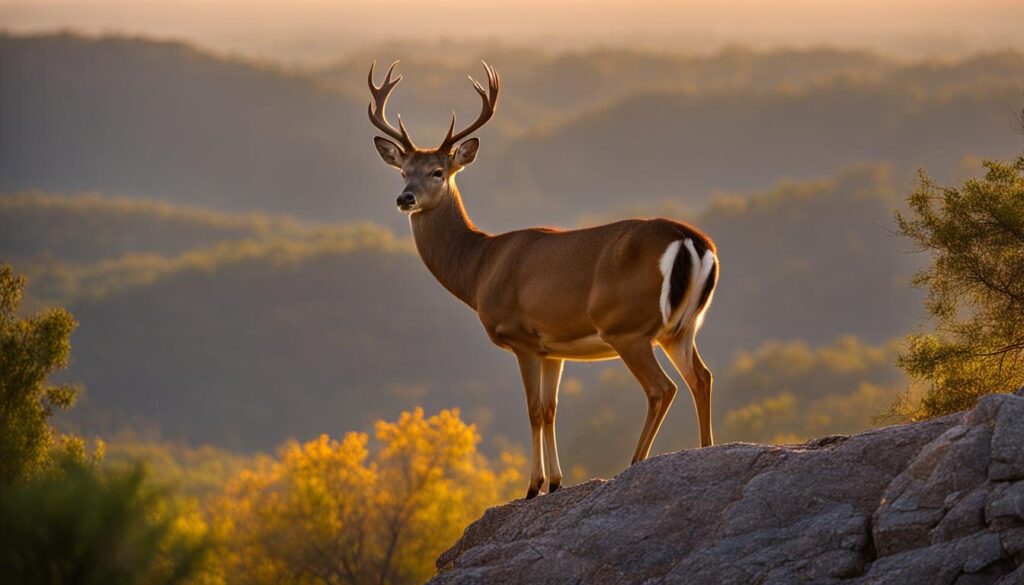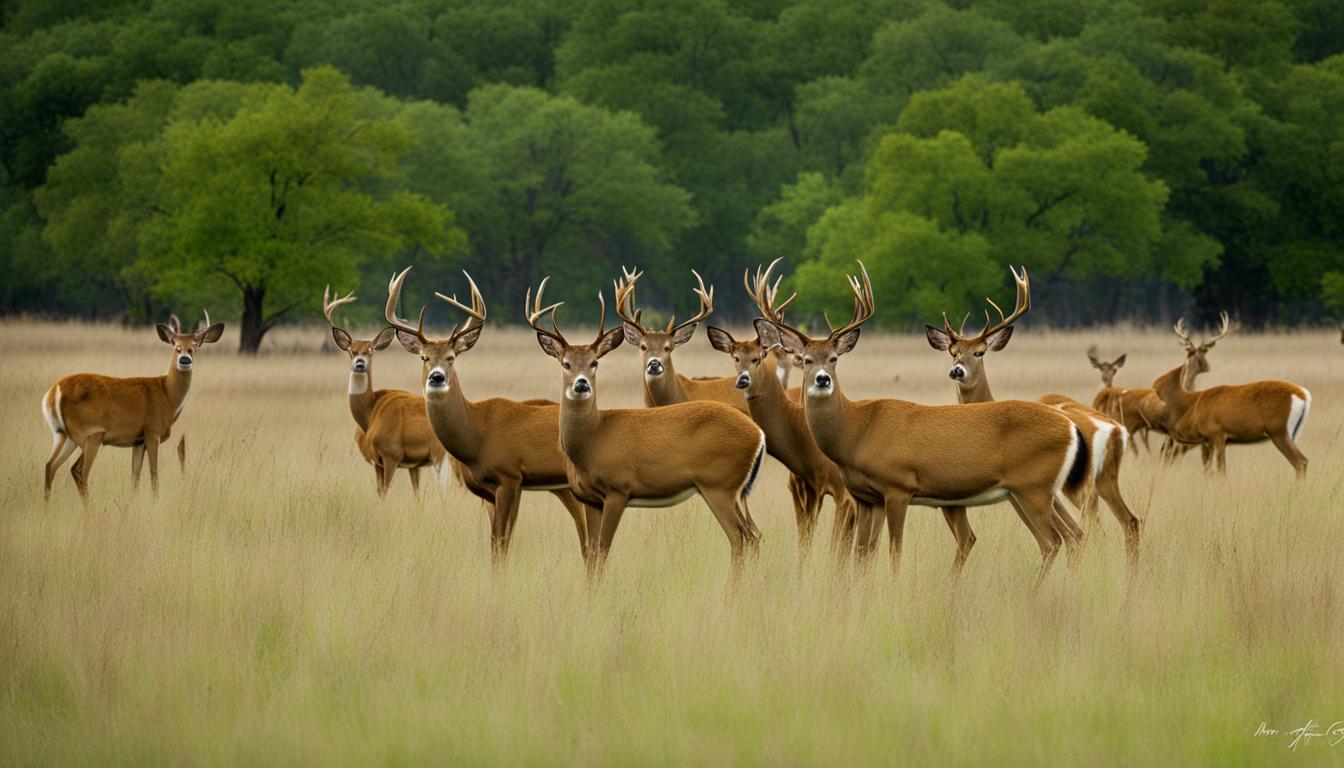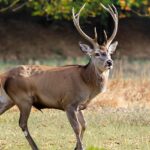Texas is known for its rich wildlife, and among its diverse range of animals, deer species hold a prominent place. From the majestic white-tailed deer to the elusive mule deer and the exotic axis deer, Texas offers a habitat for these captivating creatures.
The Lone Star State boasts a significant deer population, with over four million white-tailed deer alone. Whether you are a nature enthusiast or an avid hunter, understanding the different species and their habitats is essential for deer management and hunting regulations in Texas.
Exploring the world of Texas deer species is a fascinating endeavor, and this complete guide will take you on a journey into their captivating lives.
Content Highlights
ToggleKey Takeaways:
- Texas is home to diverse deer species, including white-tailed deer, mule deer, and axis deer.
- The state has a large deer population, with over four million white-tailed deer.
- Understanding deer habitats and behaviors is crucial for deer management and hunting regulations in Texas.
- The Texas Hill Country is renowned for its dense population of white-tailed deer.
- White-tailed deer can be found throughout the state, while mule deer primarily inhabit the Trans-Pecos region of west Texas.
White-tailed Deer in Texas
The white-tailed deer is the most common big game species in Texas. It can be found throughout the state, with the highest population density in the Texas Hill Country, specifically the Edwards Plateau.
White-tailed deer inhabit a variety of habitats, including forests, swamps, open brushy areas, foothills, plains, and river bottoms. They are herbivores, primarily feeding on forbs, browse, twigs, shrubs, acorns, fungi, and grasses.
Understanding their movement patterns, breeding season (rut), and the presence of twin fawns is essential for deer management and hunting regulations in Texas.

Mule Deer in Texas
Mule deer, known for their majestic presence, can predominantly be found in the High Plains and Trans-Pecos regions of west Texas. These stunning creatures possess a reddish summer coat that gracefully transitions into a mesmerizing blue-gray winter coat.
Thriving within a diverse range of habitats, mule deer have adapted to various ecosystems such as forests, desert shrubs, chaparral, grasslands, plains, foothills, and river bottoms. With their herbivorous nature, mule deer feed on a diet primarily composed of forbs, browse, shrubs, twigs, and grasses.
One must comprehend their limited movement patterns, especially within the Trans-Pecos region, as well as familiarize themselves with the distinctive behaviors exhibited during their breeding season, or rut. An enthralling sight that plays out during this period is the spirited battles initiated by male mule deer.
Understanding the intricate details of mule deer behavior, their preferred habitats, and their significance within the ecosystem is crucial for efficient deer management and adherence to deer hunting regulations in the Lone Star State.
Mule Deer Habitat Examples
| Habitat Type | Examples |
|---|---|
| Forests | Piney woods, mixed woodlands |
| Desert Shrubs | Sand sagebrush, creosote bush |
| Chaparral | Montane, coastal sage scrub |
| Grasslands | Shortgrass, tallgrass prairies |
| Plains | Rolling plains, open meadows |
| Foothills | Terrain transitioning to mountains |
| River Bottoms | Woodlands near rivers and streams |
Mule Deer Diet
- Forbs
- Browse
- Shrubs
- Twigs
- Grasses
Axis Deer in Texas
Axis deer, also known as chital, are a magnificent species that can be found in various parts of Texas, particularly in the Hill Country and other suitable habitats. They are known for their striking reddish-brown coat adorned with white spots, creating a visually stunning appearance.
These beautiful creatures thrive in a range of habitats, showcasing their adaptability and resilience. Axis deer can be found in forests, swamps, open brushy areas, foothills, plains, and river bottoms, making them versatile inhabitants of the Texas landscape.
As herbivores, axis deer primarily feed on a diverse diet that includes forbs, browse, shrubs, twigs, and grasses. Their feeding habits contribute to the ecological balance of their habitats and make them an essential part of the Texas wildlife ecosystem.
Understanding the behavior of axis deer is crucial for effective deer population management and hunting regulations in Texas. By gaining insights into their behavior and habitat preferences, wildlife managers and hunters can make informed decisions that promote conservation and sustainable hunting practices.
To ensure the preservation of axis deer populations, hunting regulations play a vital role in maintaining a balance between conservation efforts and recreational hunting activities. These regulations aim to protect the species while offering hunting opportunities that contribute to wildlife management and the economy.
By respecting the hunting regulations and guidelines set forth by the Texas Parks and Wildlife Department, individuals can participate in the thrill of hunting axis deer while actively contributing to the long-term sustainability of these magnificent creatures.

Axis Deer Facts:
- Scientific name: Axis axis
- Also known as chital or spotted deer
- Distinct reddish-brown coat with white spots
- Known for their graceful and elegant appearance
- Range of habitats include forests, swamps, open brushy areas, foothills, plains, and river bottoms
- Herbivores that primarily feed on forbs, browse, shrubs, twigs, and grasses
- Contribute to the diversity and balance of the Texas wildlife ecosystem
“The axis deer’s beauty and adaptability make them a valuable asset to the Texas wildlife landscape. Understanding their behavior and habitat preferences is crucial for conservation and hunting practices.” – Texas Wildlife Expert
Conclusion
Texas is renowned for its diverse range of deer species, including the majestic white-tailed deer, the iconic mule deer, and the striking axis deer. Understanding the unique characteristics, habitats, and behaviors of these deer species is crucial for effective deer management and hunting regulations across the state.
With a large deer population, particularly abundant in the Texas Hill Country, maintaining a balance between conservation and recreational hunting activities is essential. Proper deer management ensures a sustainable and thriving wildlife ecosystem in Texas, allowing these magnificent creatures to coexist harmoniously with their surroundings.
For hunting enthusiasts, Texas offers exciting opportunities to experience the thrill and challenge of deer hunting in various landscapes. From the scenic Edwards Plateau to the vast Trans-Pecos region, there is a wide range of terrains and habitats to explore, each offering its own unique hunting experience.
Whether you are a seasoned hunter or a beginner, embarking on a deer hunting adventure in Texas promises unforgettable moments and the chance to connect with nature. So gear up, obtain the necessary permits, and immerse yourself in the rich hunting traditions and bountiful wildlife that Texas has to offer.
- California Deer Hunting Guide: Seasons, Rules, Permits, and More - 26 June 2024
- Arkansas Deer Season 2024 [Schedules, Licenses, Bag Limits & More!] - 26 June 2024
- 2024 Arizona Deer Season New Dates & Rules! - 25 June 2024




